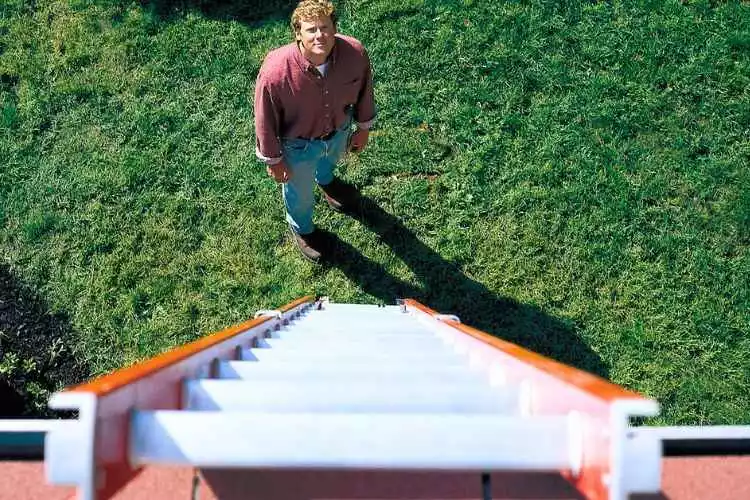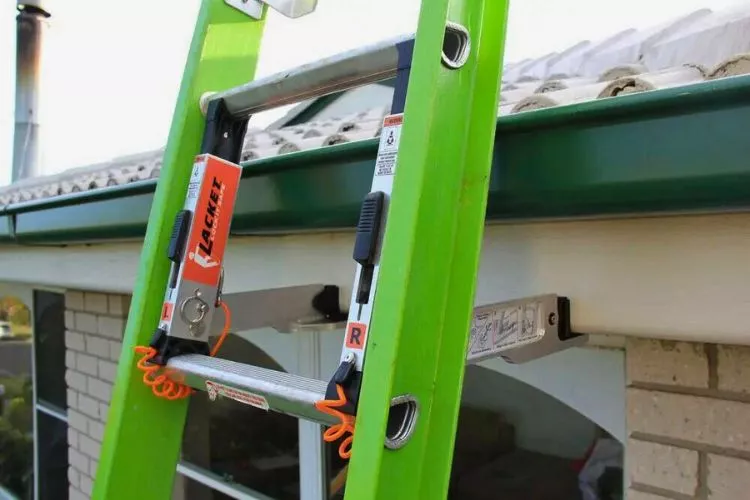It’s almost a common sense that you must learn how to stabilize ladder on roof to avoid any sort of accidents. Because, otherwise it may cause more harm than good.
To keep your ladder from sliding off your roof, ensure it’s set at the correct angle (75-degree or 4-to-1 rule). Extend the ladder 3 feet above the roofline for secure contact.
Utilize accessories like roof ladder hooks or standoff stabilizers to enhance stability at the top. Ladder hooks attach to rungs and secure the ladder to the roof, while standoff stabilizers provide additional support by resting on the roof.

Lastly, consider using anti-slip pads, ladder levelers, and a stabilizer bar to secure the ladder base and provide additional stability during work. I have explored the essential techniques and equipment to stabilize ladder on roof, minimizing risks and maximizing productivity.
How to stabilize ladder on roof? (The Truth)
Climbing a ladder to work on a roof can be a daunting task. To ensure safety and efficiency, it’s crucial to know how to stabilize ladder on roof properly.
This guide will discuss the steps to set up, stabilize, and work safely with a ladder on a roof.
🪜 Proper Ladder Setup

Selecting a Suitable Location
- Firm and Level Ground: Ensure the ground beneath the ladder is firm and level. Uneven surfaces can lead to instability and increase the risk of accidents.
- Avoiding Hazards: Always set the ladder away from power lines and slippery surfaces. Be mindful of other hazards, such as overhanging branches or loose debris.
Setting Up the Ladder at the Correct Angle
- 75-Degree Rule: Position the ladder at a 75-degree angle to the ground. This helps to distribute weight evenly and prevent the ladder from slipping backward.
- 4-to-1 Rule: For every four feet of ladder height, the base should be one foot away from the wall or structure it is leaning against. This ensures the ladder remains stable and secure.
Extending the Ladder Above the Roofline
- Proper Overlap for Extension Ladders: When using an extension ladder, ensure that the sections overlap by at least three feet to maintain stability.
- Ensuring Secure Contact with the Roof: The ladder should extend at least three feet above the roofline to facilitate safe and easy access.
🪜 Stabilizing the Ladder Base

Using Ladder Levelers
- Types of Levelers: Ladder levelers are adjustable feet that can be attached to the ladder legs to accommodate uneven ground.
- Installation and Adjustment: Levelers can be installed following the manufacturer’s instructions and adjusted to ensure the ladder remains level and stable.
Securing the Ladder Feet
- Anti-Slip Ladder Pads: Attach rubber or anti-slip pads to the ladder feet to prevent slipping on concrete or wet grass surfaces.
- Securing the Ladder to Stakes or Anchor Points: Use ropes or straps to secure the ladder to stakes or other anchor points for added stability.
Utilizing a Ladder Stabilizer Bar
- Benefits of Using a Stabilizer Bar: Stabilizer bars provide additional support and help prevent the ladder from slipping sideways.
- Proper Installation: Follow the manufacturer’s instructions to install the stabilizer bar correctly.
🪜 Stabilizing the Ladder Top

Roof Ladder Hooks
- Different Types of Hooks: Roof ladder hooks can be attached to the top of the ladder to secure it to the roof’s edge.
- Proper Attachment and Use: Follow the manufacturer’s instructions for properly attaching and using roof ladder hooks.
Ladder Standoff Stabilizers
- Advantages of Using Standoff Stabilizers: Standoff stabilizers keep the ladder away from the wall or structure, providing extra stability and preventing damage to gutters or siding.
- Installation and Positioning: Install standoff stabilizers according to the manufacturer’s instructions, and position them to rest securely against the roof.
🪜 Working Safely on the Ladder

Climbing and Descending Techniques
- Three Points of Contact: Always maintain three points of contact with the ladder – two hands and one foot or two feet and one hand.
- Facing the Ladder While Climbing: Always face the ladder to maintain balance and control while climbing up or down.
Proper Body Positioning
- Center of Gravity: Keep your body’s center of gravity between the ladder’s side rails to prevent tipping or losing balance.
- Avoiding Overreaching: Never overreach while on a ladder. Instead, climb down and reposition the ladder as needed.
Using Tools and Equipment Safely
- Tool Belts and Bags: Use tool belts or bags to keep tools and equipment within easy reach while working on the ladder.
- Ladder Accessories: Consider using ladder accessories, such as tool hooks or trays, to help keep tools and materials organized and close at hand.
By following these guidelines, you can ensure your ladder is stable and secure, allowing you to work safely and efficiently on any roof. Always prioritize safety when using a ladder and follow the manufacturer’s instructions for proper setup and use.
How to put a ladder on a sloped roof?

- Assess the Slope and Roof Surface: Before setting up the ladder, evaluate the slope and roof surface to determine the right equipment and setup. Check for any hazards like wet leaves, loose shingles, or ice.
- Select the Right Ladder: Choose a ladder long enough to extend at least 3 feet above the roof edge. Extension ladders are ideal for sloped roofs due to their adjustable length.
- Set Up Ladder on Level Ground: Find a level and firm spot to set up the ladder base. Use ladder levelers if the ground is uneven to ensure the ladder remains stable.
- Position the Ladder at the Correct Angle: Adhere to the 4-to-1 rule: the base should be one foot away from the wall for every four feet of ladder height. This ensures a stable 75-degree angle.
- Install Ladder Stabilizers or Hooks: Attach a ladder stabilizer or roof ladder hook to the top of the ladder. These accessories help secure the ladder to the roof and prevent it from slipping.
- Extend the Ladder Above the Roofline: Extend the ladder at least 3 feet above the roof edge to provide a secure handhold while transitioning from the ladder to the roof.
- Secure Ladder Feet and Base: Place anti-slip pads on the ladder feet and consider tying the ladder base to stakes or anchor points for added stability.
- Climb the Ladder Safely: Maintain three points of contact while climbing the ladder. Always face the ladder and avoid overreaching.
- Transition onto the Roof: Once you reach the top, firmly grasp the ladder above the roofline with both hands. Carefully step onto the roof, maintaining your balance and footing.
- Work Safely on the Sloped Roof: Utilize roofing shoes with good traction, and consider using a roof safety harness for added security while working. When finished, carefully return to the ladder and descend safely.
Frequently Asked Questions (FAQs)
u003cstrongu003eCan I use a ladder stabilizer on a roof?u003c/strongu003e
Yes, a ladder stabilizer can be used on a roof to help prevent the ladder from slipping or moving sideways. The stabilizer provides additional support and helps distribute the ladder’s weight evenly.
What is the best method for stabilizing a ladder?
The best method for stabilizing a ladder involves the following:u003cbru003e☑️ Setting it up on level ground.u003cbru003e☑️ Positioning it at the correct angle (75-degree angle).u003cbru003e☑️ Securing the base with anti-slip pads or ladder levelers.u003cbru003eA ladder stabilizer bar and roof ladder hooks can also help keep the ladder stable while working on a roof.
Is there something to stop a ladder from slipping?
Yes, several things can be done to stop a ladder from slipping. One effective method is to use anti-slip ladder pads or shoes. These provide a secure grip on the ground, preventing the ladder from sliding. Alternatively, ladder levelers, stabilizer bars, and roof ladder hooks can help keep the ladder stable and prevent it from slipping or moving on a roof.
Conclusion:
Knowing how to stabilize ladder on roof ensures safety and efficiency while working at height. By selecting the appropriate ladder, setting it up on level ground, and securing it with the correct angle, you significantly reduce the risk of accidents.
Additionally, ladder stabilizers, roof hooks, anti-slip pads, and other safety equipment can enhance stability and provide peace of mind during your project.
By following these guidelines and prioritizing safety, you can confidently and securely navigate your ladder and roof work, making your tasks manageable and successful.


